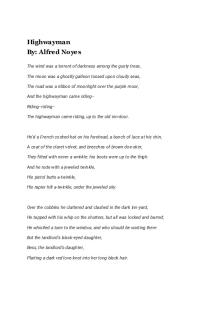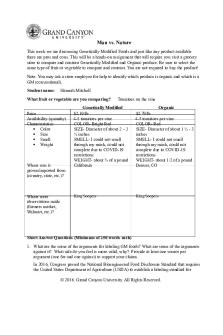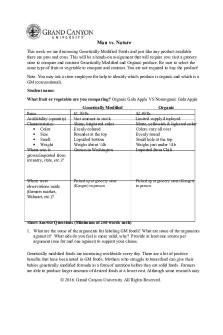Man VSnature worksheet PDF

| Title | Man VSnature worksheet |
|---|---|
| Author | cece williams |
| Course | Environmental Science |
| Institution | Grand Canyon University |
| Pages | 4 |
| File Size | 144.8 KB |
| File Type | |
| Total Downloads | 45 |
| Total Views | 142 |
Summary
Man vs nature worksheet...
Description
Man vs. Nature This week we are discussing Genetically Modified Foods and just like any product available there are pros and cons. This will be a hands-on assignment that will require you visit a grocery store to compare and contrast Genetically Modified and Organic produce. Be sure to select the same type of fruit or vegetable to compare and contrast. You are not required to buy the product! Note: You may ask a store employee for help to identify which produce is organic and which is a Non-organic. Student name:
Cecillia Williams
What fruit or vegetable are you comparing? Price Characteristics: Color Size Smell Weight
Bananas
Non-organic $0.49/lb The color of the bananas were half yellow/half green. The length was about 8-inches. Upon smelling the produce, it smelled like dirt. The weight of an 8-piece bundle was 2lbs/4oz.
Where was it grown/imported from (country, state, etc.)?
The company distributor was Dole. They were imported from Guatemala, and displayed Disney characters on the label (most likely for marketing purposes).
Where were observations made (farmers market, Walmart, etc.)?
The observation was made at Fred Meyer (the local grocery store chain native to the Pacific Northwest). Stores average at about 150,000 sqft and offer more than 225,000 items (Fred Meyer.com, 2018).
Short Answer Questions (Minimum of 150 words each)
Organic $0.69/lb The organic bananas were mostly green with some yellow but had a considerably more vibrant color than its counterpart. The bananas were 5-6 inches in length. Upon smelling the bananas, it was fruity like a banana smells when you open it. The weight of an 8piece bundle was 2lbs/3oz, ironically similar to the nonorganic product. The company distributor was Dole Organics. They were imported from Peru. On the label it was stamped with “Control Union Certification,” certifying the authenticity of organic. The observation was made at Fred Meyer (grocery store chain native to the Pacific Northwest).
1. What are the some of the arguments for labeling GM foods? What are some of the arguments against it? What side do you feel is more valid, why? Provide at least one source per argument (one for and one against) to support your claims. Genetically Modified foods are natural food items that have been genetically altered by inserting one species into another to create a desired result of genetically engineered proportions (Ruhs, 2013). These lab-created genetic variances are desired for their ability to increase production at a lower cost, fewer pest issues, and the reduction of pesticides; providing an enhanced sustainability of foods (Adam, 2015). When it comes to labeling GM foods, there is a debate whether this should be an imposed practice. Some would argue that due to a lack of research on the long-term health effects for humans, labeling foods that are genetically modified is essential for the avoidance of these unnatural products (Ruhs, 2013). The argument against GMO labeling describes that 70% of food is genetically modified in some way, so to mandate GM labeling on products, is to create the irrational fear and misconceptions that all modifications are detrimental to human consumption (Davis, 2016). I do believe that there is not enough evidence to support whether genetically modified food is detrimental to mankind’s health. The longevity of GMO use is not enough to discern either argument. I do not believe all modifications are unhealthy but are introduced to provide a larger scale production of food availably for the population of the world. 2. Do you feel as though GMO foods are the answer to end world hunger? Why or why not? If GMOs are the answer to the shortages, why do food prices keep going up? I believe that GMOs enhance the yields of produced foods which in turn combats the future shortage of nutrient supplies for mankind. It is shown that the implementation of genetically engineered crops is increasingly accepted throughout developing countries for the specific purpose of alleviating poverty and hunger, with the projected rate of more than 400 million acres of these kinds of harvests throughout 40 countries in the near future (Maghari & Ardekani, 2011). Although GMOs are the promised answer to famine and shortage, food prices are still on the rise. This is due to the consumption rate in correlation to the energy used for the population increase. With the increase of food consumption in turn increases the production of foods, equaling an increase in methods, resources, and energy needed to sustain the rate of intake associating with the population influx of the world (Webber, 2012). By using more resources within the method, whether it be organic or GMO, it naturally enhances the process on which production thrives.
3. What are some ethical concerns or benefits of using GMOs based on the Christian Worldview? (Refer to “Here’s What Religious Experts Have to Say About Faith and GMOs” for help answering this question.)
According to the views of Christians, GMOs have both adverse and beneficial remarks regarding the promised results of these methods. They believe that as long as a strong ethical backing and integrity is considered with the production of GMOs especially with the consideration of alleviating world poverty and hunger, the precautionary path can be taken to modify nutritional resources (Smith, 2015). The concern of these large corporations producing these yielding seeds, is that farmers can become reliant on what GMOs offer leading into an agricultural-corporation relationship of slavery to the genetically modified seed (Smith, 2015). It can also become concerning when considering the potential damage, the excessive and permanent use of crops that are GM friendly and the relationship to the natural environment. According to the Christian Worldview, the best practice would be to meet the farmers at ground level and find another solution to the food shortage, instead of relying so heavily on giant corporations that provide promise of significant increases of yielding crops with little to no detriment (Smith, 2015).
References Adam, N. (2015). Population growth and the environment. In Grand Canyon University (Ed.) Environmental Science: The Human Impact on Natural Resources. Available from
http://lc.gcumedia.com/bio220/environmental-science-the-human-impact-on-naturalresources/v1.1/#/home Davis, J. (2016). Why we shouldn’t label GMO foods. Iflscience.com. Retrieved from: https://www.iflscience.com/environment/why-we-shouldnt-label-gmo-foods/all/ Fred Meyer.com. (2018). History of Fred Meyer. Retrieved from: https://www.fredmeyer.com/topic/history-2 Maghari, B. M., & Ardekani, A. M. (2011). Genetically Modified Foods and Social Concerns. Avicenna Journal of Medical Biotechnology, 3(3), 109–117. Retrieved from https://lopes.idm.oclc.org/login?url=http://search.ebscohost.com/login.aspx? direct=true&db=a9h&AN=65456490&site=ehost-live&scope=site
Ruhs, B. (2013). Update: GMOs in foods. Environmental Nutrition, 36(2), 1–6. Retrieved from https://lopes.idm.oclc.org/login?url=http://search.ebscohost.com/login.aspx? direct=true&db=a9h&AN=84988040&site=ehost-live&scope=site
Smith, M. (2015). Here’s what religious experts have to say about faith and GMOs. Vice News. Retrieved from: https://news.vice.com/en_us/article/neyw5z/heres-what-religiousexperts-have-to-say-about-faith-and-gmos Webber, M. E. (2012). More Food, Less Energy. Scientific American, 306(1), 74–79. Retrieved from https://lopes.idm.oclc.org/login?url=http://search.ebscohost.com/login.aspx? direct=true&db=a9h&AN=70198879&site=ehost-live&scope=site...
Similar Free PDFs

Man VSnature worksheet
- 4 Pages

Highway man
- 8 Pages

Age of man - Age of Man
- 3 Pages

BUS MAN Notes
- 43 Pages

questions on lan /man
- 7 Pages

Assignment 2 - Demolition Man
- 9 Pages

Reasonable man test crim
- 3 Pages

Man vs Nature
- 3 Pages

Man VS Nature Worsksheet
- 3 Pages

Fertiliteit van de man
- 12 Pages

Pengertian LAN , MAN ,WAN
- 39 Pages

Rain Man - Grade: 75
- 7 Pages

The Mismeasure of Man
- 2 Pages

Reseña Herzog Grizzly Man
- 2 Pages
Popular Institutions
- Tinajero National High School - Annex
- Politeknik Caltex Riau
- Yokohama City University
- SGT University
- University of Al-Qadisiyah
- Divine Word College of Vigan
- Techniek College Rotterdam
- Universidade de Santiago
- Universiti Teknologi MARA Cawangan Johor Kampus Pasir Gudang
- Poltekkes Kemenkes Yogyakarta
- Baguio City National High School
- Colegio san marcos
- preparatoria uno
- Centro de Bachillerato Tecnológico Industrial y de Servicios No. 107
- Dalian Maritime University
- Quang Trung Secondary School
- Colegio Tecnológico en Informática
- Corporación Regional de Educación Superior
- Grupo CEDVA
- Dar Al Uloom University
- Centro de Estudios Preuniversitarios de la Universidad Nacional de Ingeniería
- 上智大学
- Aakash International School, Nuna Majara
- San Felipe Neri Catholic School
- Kang Chiao International School - New Taipei City
- Misamis Occidental National High School
- Institución Educativa Escuela Normal Juan Ladrilleros
- Kolehiyo ng Pantukan
- Batanes State College
- Instituto Continental
- Sekolah Menengah Kejuruan Kesehatan Kaltara (Tarakan)
- Colegio de La Inmaculada Concepcion - Cebu

